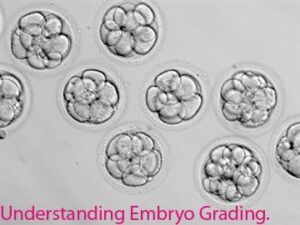 The success of IVF treatment depends upon a variety of factors. One of the most significant amongst these is the quality of embryo. Poor quality embryo is most likely to yield a failed cycle due to implantation failure. If pregnancy does take place, there is risk of fetal abnormalities, miscarriage, or other birth-related complications. Embryo quality is, therefore, a matter of great concern for patients undergoing IVF treatment. The evaluation of embryo quality is done during various stages of it culture. It is done to make sure that only the ones which are of viable quality are considered for transfer.
The success of IVF treatment depends upon a variety of factors. One of the most significant amongst these is the quality of embryo. Poor quality embryo is most likely to yield a failed cycle due to implantation failure. If pregnancy does take place, there is risk of fetal abnormalities, miscarriage, or other birth-related complications. Embryo quality is, therefore, a matter of great concern for patients undergoing IVF treatment. The evaluation of embryo quality is done during various stages of it culture. It is done to make sure that only the ones which are of viable quality are considered for transfer.
Embryo quality is described in the form of grades, with the process called embryo grading. The embryo grade defines its potential for development and capability of implanting itself to grow into a healthy pregnancy. The grading system followed by infertility clinic is subjective and may vary from clinic to clinic. It is important to understand embryo grading in detail to know the minimum quality standard that an embryo needs to generate a successful IVF cycle.
Understanding the Embryo Grading Parameters
During a typical IVF cycle, the female eggs are fertilized by male sperms in a lab dish to create embryos. The embryos are transferred in the uterus on day 3 (cleavage stage) or day 5 (blastocsyt stage). The stage of embryo transfer depends upon the protocol followed by the IVF clinic carrying out the cycle. Embryo grading is done at these stages to evaluate the embryos before proceeding with the transfer.
Cleavage Stage Embryo Grading
Cleavage stage embryo grading refers to the study of embryo quality on day 3 of culture. Embryo grading is done on the basis of three parameters:
- Number of cells in the embryo, preferably 7-10 cells considered as a feasible number for healthy day 3 embryo
- Appearance of the embryonic cells, with cells to be of a similar size for the embryo to be regarded as a high quality one
- Degree of fragmentation, which is defined as the presence of minute fragments of cellular material which have disintegrated during the cell division process. Little or no fragmentation defines a high grade embryo
Other factors that are studied microscopically for studying the embryo quality include presence of multinucleation, thickness of zona pellucida, existence of vacuoles, and granularity of the embryos.
As said before, an embryo with 7-10 cells at this stage is regarded as a good quality embryo. On the other hand, embryo grading is done by clinics on the basis of subjective combinations of the other quality parameters. Grade 1 is given to embryos with cells of equal size and no fragmentation. Those with equally sized cells and minor fragmentation are assigned grade 2. The grades go down as embryo quality deteriorates in terms of cellular sizes and degree of fragmentation. Grade 5 goes to the embryos with cells of unequal size and heavy fragmentation. Embryos with Grade 1 to 2.5, with a minimum of 6-7 cells, are regarded as the best for transfer as they have optimal chances of growth and implantation.
Blastocyst Stage Embryo Grading
IVF clinics which conduct embryo transfer on day 5 of the culture perform grading at the blasocyst stage. Most embryologists adopt the Gardner System for grading blasotcyst stage embryos. The system considers two parts of the embryo for the purpose of grading, the inner cell mass (ICM) and the trophectoderm epithelium (TE). Both these parts lie within a fluid cavity. The ICM subsequently grow into the fetus and TE develops into placenta once pregnancy takes place.
Day 5 embryos experience rapid cell division and growth, with the embryo outgrowing the outer shell, zona pellucida. The zona thins out due to expansion, which makes it ready for hatching at the time of implantation. Both the ICM and TE grow during the process and the fluid cavity gets enlarged. These embryos are assigned grades according to the quality of ICM and TE. While A indicates excellent quality, B defines good, C fair and D poor quality. The embryologist would consider high grade embryos for transfer so that the chances of a healthy pregnancy are maximized.
Embryo grading gives a fair idea about the quality of embryos. Using these grades, the IVF specialist and embryologist can identify the healthiest of embryos to be used for transfer. At the same time, embryo grades cannot be considered in isolation to predict the fate of IVF pregnancy. Parameters like maternal age, fertility history, and other complications are seen in combination to make the decision. There have been instances when embryos with mediocre grades have yielded healthy pregnancies and grown into beautiful babies. Still, the reliability of embryo grading cannot be questioned because it helps in maximizing IVF success rate. Also, frozen high grade embryos assure future fertility for the patients.
Gaudium IVF is a trusted IVF centre in Delhi where the patients are offered the best and the latest infertility treatment at affordable cost. The clinic brings high-tech procedures for maximizing the success rate of the treatment procedure.
For a free second opinion from Dr Manika Khanna, the award-winning infertility specialist in Delhi, visit Gaudium IVF today.



